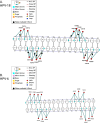Structural and functional roles of conserved residues of human papillomavirus (HPV) E2 protein and biological consequences
- PMID: 40804408
- PMCID: PMC12345011
- DOI: 10.1186/s12985-025-02903-7
Structural and functional roles of conserved residues of human papillomavirus (HPV) E2 protein and biological consequences
Abstract
Background: Human papillomavirus (HPV) is a prevalent viral pathogen that causes a variety of malignancies, including cervical cancer, one of the leading causes of cancer-related deaths among women worldwide. The HPV E2 protein is a central regulator of viral replication and oncogene expression, making it a critical determinant of HPV-associated malignancies. While its core functions are conserved, variations within the E2 protein are thought to contribute to the differential oncogenic potential among HPV types, though the structural basis for this remains incompletely understood. Previous research from our laboratory suggests that mutations within a 12-base pair segment of the long control region that encompasses the E2 binding sites may influence the oncogenic potential of certain HPV strains.
Methods: Computational methods, including multiple sequence alignment, phylogenetic analysis, and protein structural modeling were employed to identify conserved regions and correlate these with potential cancer-associated mutations in the coding region.
Results: Structural modeling using AlphaFold3 and visualization in PyMOL revealed that conserved E2 residues cluster near the DNA-binding surface in the C-terminal domain and at critical interaction sites in the N-terminal transactivation domain, important for E1 DNA helicase binding and potentially other host factor interactions. Notably, species-specific adaptations, including the T309P substitution in the HPV52 subfamily B2, which may induce structural changes in the DNA-binding domain, and variations in the 12-base pair spacer, could modulate oncogene expression.
Conclusions: Collectively, these findings refine our understanding of E2's essential role in viral pathogenesis and highlight promising targets for therapeutic intervention in high-risk HPV strains.
Keywords: DNA-binding domain; E2 protein; Human papillomavirus; Oncogenic potential; Sequence conservation; Structural modeling; T309P mutation; Transactivation domain.
© 2025. The Author(s).
Conflict of interest statement
Declarations. Ethics approval and consent to participate: Not applicable. Consent for publication: All authors have explicitly authorized this publication. Competing interests: The authors declare no competing interests.
Figures







References
-
- Han F, Guo X, ying, Jiang M, xia, Xia Nshao, Gu Y, Li S. wei. Structural biology of the human papillomavirus. Structure. 2024;32(11):1877–92. - PubMed
MeSH terms
Substances
LinkOut - more resources
Full Text Sources

